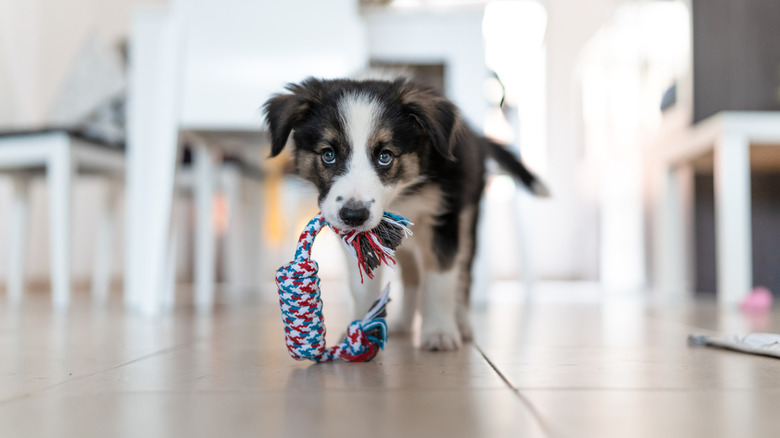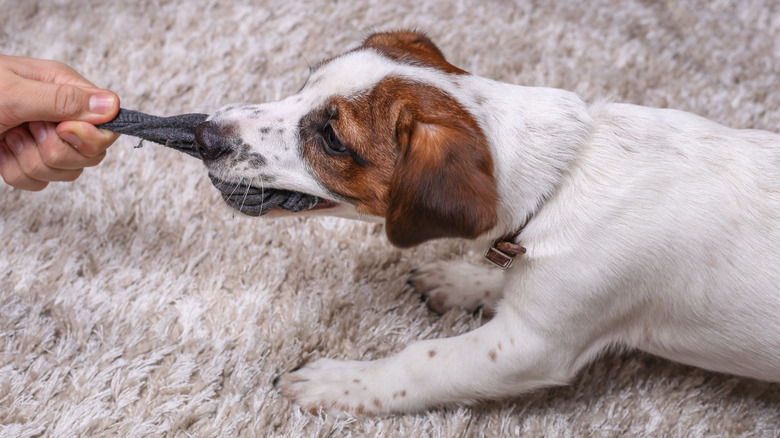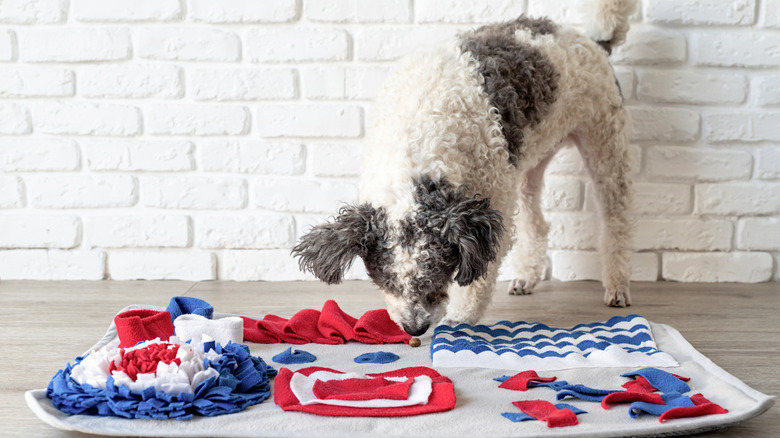At What Point Should You Throw Your Dog's Favorite Toy Away?
Maybe it's the stuffed squeaky duck, or the big rubber ring, or the double-knotted rope – every dog has a favorite toy. Some have more than one, and with daily and sometimes aggressive chewing, these playthings can certainly take a beating. They can also get dirty and start to smell after a while. Sure, you might be able to wash them, but at what point should you throw away your dog's favorite toy? The simple answer is: when they start posing a risk to your canine companion, or if your dog tests positive for parvovirus, but there are ways to expand the lifespan of these toys.
A cotton-stuffed toy with even the strongest of stitching can't stay intact for long when a strong-jawed chews on it regularly. Over time, those sharp teeth can create punctures, leading your pup to start "gutting" the toy. They might even swallow the cotton stuffing, creating a choking or internal blockage risk. As a rule of thumb, any toy with small parts, or that gets chewed into small parts, can pose these risks. Certain stuffing-free dog toys can also be dangerous if they're too hard or become too sharp, since they can injure your dog's teeth and mouth.
Another reason to toss out your dog's favorite toy is after a parvovirus diagnosis. Parvovirus is a contagious disease that can be transferred from one dog to another via a contaminated toy. However, the good news is that if the toy is non-porous, you can clean it with bleach, which will kill the virus. Soft/absorbent toys should be thrown away because it's more challenging to kill the virus from porous surfaces.
How to get rid of the toy without upsetting your dog
When it's time to dispose of the toy for good, understand that your dog may not be happy about the change. As dog trainer Liz Kover explained to The Dodo, many dogs grow attached to one specific item because it provides them with a sense of familiarity. "That one toy [...] it's part of their repertoire of their comfort things that make up their world," she said. As such, some dogs can become protective of their favorite toys and turn to behaviors like resource-guarding to prevent the from being taken. To prevent this from happening, make sure you dispose of the item when they're not looking, and never try to take it directly from their mouth if they're showing guarding behaviors.
That said, if you're worried about your dog becoming upset with you after losing their favorite toy, there's no need to worry. Even though dogs are capable of holding long-term memories, there's little research that demonstrates they can actually hold a grudge against you — even if you do dispose of their favorite squeaky ball. If you've noticed your dog has changed their behavior after removing the toy, you can talk to your trainer or vet.
Porolong the life of your dog's favorite toys
A toy that's chewed on daily might last for only a month or so. You probably don't want to buy replacements that often, so consider the ways you can extend the lifespan of your dog's favorite toy. The first is by increasing the quantity; once you realize which toy your four-legged friend fancies the most, buy a couple more just like it. This allows you to rotate the toys on a weekly basis to preserve them.
You can also can create other entertainment opportunities for them, such as using a snuffle mat to hide food or treats in. This will keep your companion busy as they forage through the mat in search of the edibles. Alternatively, you can purchase an interactive puzzle to keep your dog mentally stimulated. By giving them other play options, you'll help them not rely solely on one toy for entertainment. Moreover, conditioning them to engage with other items means prolonging the life of other potential toys. After your dog has found all the treats, they may just want to rest or be less aggressive with their favorite chewy ball.
You can also create entertainment for your pooch outside your home. How many times have you seen a dog with a toy in their mouth while being walked on a leash, or while running through the park? Probably never. That's because the stimuli of the great outdoors, coupled with curiosity, temporarily replaces any interest in an indoor toy for most dogs. So try to make time for those daily walks or trips to the park to create balance for your dog.


